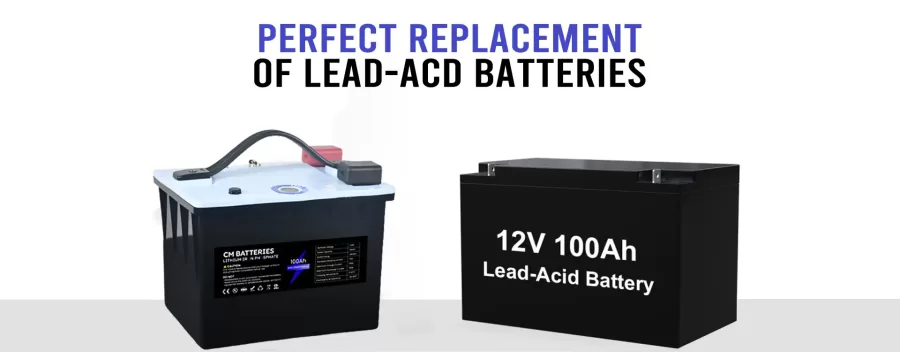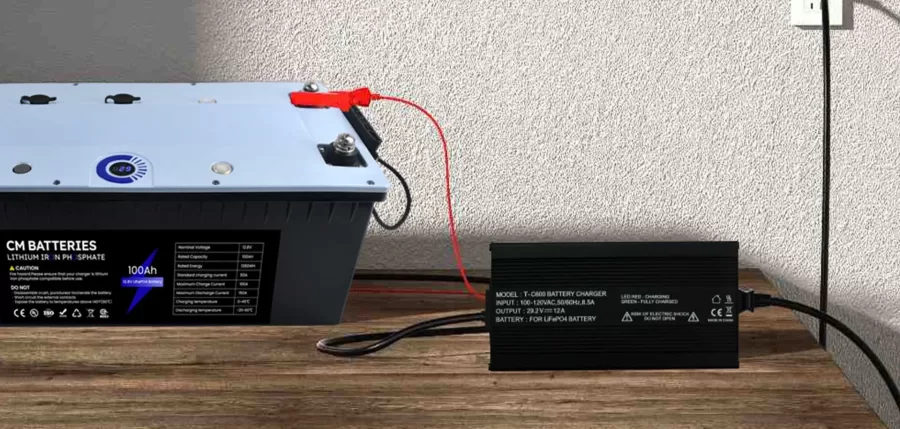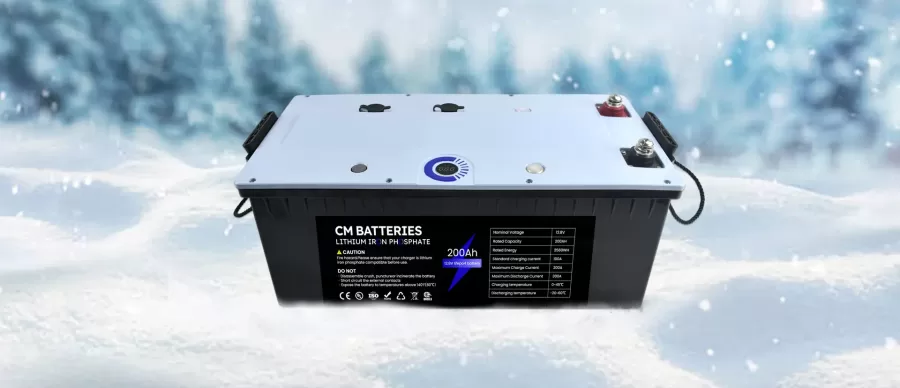Lithium iron phosphate (LiFePO4) battery packs are one of the most popular pets in various industries due to their high energy density, long lifespan, and eco-friendly properties. However, there are a lot of questions that come up when LiFePO4 batteries own more market shares. In this blog post, we will address some of the frequently asked questions about LiFePO4 battery packs.

Lead Acid Battery Replacement By LFP Battery FAQs
1. I want to upgrade to lithium-iron phosphate batteries. What do I need to know?
When you replace the used the lead acid battery, you clarify the capacity, power, and dimension. If you are upgrading from a lead acid battery to a LiFePO4 battery, you will benefit less dimension and weight by up to 50% with the same runtime. Our LiFePO4 batteries are compatible with the current charging sources. If you require assistance with the upgrade process, please don’t hesitate to reach out to CM Batteries technical support. They are dedicated to supporting you to get the suitable battery for your needs.
2. What is the difference between parallel and series connections?
Parallel connection is a method used to enhance the capacity of a battery pack by connecting two or more cells. In this configuration, the positive terminals of all the cells are connected, and similarly, the negative terminals are connected. This setup allows for an increased overall capacity of the battery pack, as the individual capacities of the cells are combined. The voltage across the parallel-connected cells remains the same.
On the other hand, the series connection is employed to increase the voltage of a battery system. Multiple cells are interconnected by linking the positive terminal of one cell to the negative terminal of the next cell, and so on until the desired voltage is achieved. For instance, if two 12V batteries are connected in series, the resulting battery system will have a total voltage of 24V. The capacity of the cells remains the same in a series of connections.
By utilizing parallel and series connections, battery systems can be customized to meet specific capacity and voltage requirements for various applications, allowing for flexibility and scalability in designing battery packs. Check out this article for details.
3. Will a 12V, 100Ah LiFePO4 battery run longer than a 12V, 100Ah lead acid battery under the same conditions?
Of course. Lithium Iron Phosphate batteries offer more usable capacity than lead acid equivalents. You can expect to double the runtime. Check out this article for details.
4. What Should I Change the Charge Power for LiFePO4 batteries?
Our batteries are designed to use the same charge power as lead-acid batteries.
- Alternator: Most alternators will fully charge a CMB Lithium Ion technology.
- Inverter: Set the charge voltage to 14.4V – 14.6V for optimal charging.
- Dedicated Charger: Please use the dedicated charger.

Frequently Asked Questions About Charge and Discharge
1. What are the conditions under which LiFePO4 batteries can be charged normally?
When charging LiFePO4 batteries, the most important consideration is temperature. The batteries are safely charged within a temperature range of 0°C to 45°C (32°F to 113°F). Besides, a high-quality Battery Management System (BMS) monitors the battery’s condition and prevents overcharging, over-discharging, and over-current.
However, it’s important to note that LiFePO4 batteries cannot be charged below 0°C (32°F) without external support technology, such as using heating elements. Please store the battery in the house not outside during winter.it is recommended to winterize it to ensure its survival in cold temperatures. On the other hand, LiFePO4 batteries can charge in reasonably high temperatures.
Apart from temperature, it is also essential to consider air humidity and the surrounding environment. Excessive humidity and complex environments are not suitable for charging LiFePO4 batteries as they can potentially cause damage.
2. What specification wire gauge for charge & discharge?
To recommend the proper wire specification for your system, please refer to the following table. It provides the allowable ampacities for copper cables rated at 167°F (75°C) while operating at an ambient temperature of 86°F (30°C).
| Wire Gauge (AWG) – Copper Conductors | Ampacity (Amps) |
| 14 | 25 |
| 12 | 30 |
| 10 | 40 |
| 8 | 55 |
| 6 | 75 |
| 4 | 95 |
| 2 | 130 |
| 1 | 150 |
| 1/0 | 170 |
| 2/0 | 195 |
| 4/0 | 260 |
By consulting this table and considering the expected load of your system, you can determine the appropriate wire gauge that meets your requirements.
3. Can I fully discharge a LiFePO4 battery?
CMB LiFePO4 batteries can be discharged to 100% of their capacity. However, to maximize the performance, achieve a longer cycle life, and prevent the battery from being disconnected by the Battery Management System (BMS), it is recommended to limit the discharge depth to 80%.
4. Can I use my existing lead-acid battery charger (Wet, AGM, or Gel) to charge CMB LiFePO4 batteries?
We highly recommend using a dedicated charger for LiFePO4 batteries, as it is the predominant Lithium battery chemistry in the market. If you are not sure whether your charger should have the LiFePO4 batteries, you can contact the CMB team to get guidance.
While some existing lead-acid chargers may still be able to charge our Lithium batteries, it still has some potential risks. Lead-acid chargers may encounter fault code conditions, which can cause issues and damage to other system electronics, including the charger itself. Therefore, it is strongly advised to use a dedicated Lithium battery charger.
5. How long does it take to charge a LiFePO4 battery?
Lithium Iron Phosphate batteries can be charged as fast as 1 hour. We recommend to use a rate charger that charges the battery in 2-5 hours.
6. How does the discharge rate affect the capacity?
The discharge rate of LiFePO4 batteries has minimal impact on the output capacity. Unlike lead-acid batteries, which experience a substantial reduction in capacity of up to 50% as the discharge rate increases, LiFePO4 batteries maintain a more consistent capacity regardless of the discharge rate.

Temperature Conditions How to Affect LFP Battery for Discharge & Charge FAQs
1. How does a LiFePO4 battery perform at low temperatures?
Cold temperatures affect the performance of batteries, including Lithium Iron Phosphate (LiFePO4) batteries. However, LiFePO4 batteries exhibit higher capacity and voltage retention in cold conditions compared to lead-acid batteries.
It is crucial to note the following important charging guidelines for LiFePO4 batteries in cold temperatures:
- When charging LiFePO4 batteries at temperatures below 32°F (0°C), the charge current should be reduced to 0.1C.
- For temperatures below 14°F (-10°C), the charge current must be further reduced to 0.05C.
It is essential to adhere to these guidelines to prevent irreversible damage to the battery. If the LiFePO4 battery charges below freezing temperatures, please inquire with the professional battery manufacturer to get professional guidance or low-temperature LiFePO4 battery solutions to avoid fire or damage risks.
2. What is the performance of the LiFePO4 battery under high temperatures?
High temperatures can adversely affect LiFePO4 batteries, causing reduced capacity, decreased energy storage efficiency, and accelerated self-discharge rates. Exposure to direct sunlight or excessive heat can exacerbate these effects.
It is important to note that the Battery Management System (BMS) of LiFePO4 batteries typically has a maximum temperature range of 60-80°C (140-176°F). However, the exact upper-temperature limit may vary depending on the specific model, please read the datasheet of your particular LiFePO4 battery.
Although LiFePO4 batteries generate less heat compared to other lithium chemistries, if the upper-temperature limit is reached, the BMS will safeguard the battery by shutting it down. This protective mechanism helps prevent further damage and ensures the battery’s longevity.
Some Battery Safety FAQs You Are Caring About or Concerning With
1. What is the expected lifetime of LiFePO4 batteries?
The expected lifetime of LiFePO4 batteries is 3500 cycles at a 100% depth of discharge (DOD). However, the exact lifetime depends on factors, such as usage habits, conditions, and maintenance tips.
Compared to lead acid batteries which are used in the same applications, LiFePO4 batteries will last up to 10 times longer. This extended lifespan is one of the notable advantages of LiFePO4 batteries over lead acid batteries.
It’s important to consider the specific variables of your application to determine the precise expected life time of LiFePO4 batteries in your project.
2. Are LiFePO4 batteries safer than other lithium batteries?
Iron powder is an important material used in the production of lithium iron phosphate (LiFePO₄), which serves as the cathode material in LFP batteries. LiFePO4 batteries offer notable advantages in terms of safety and environmental consciousness compared to lithium-ion batteries utilizing other cathode materials.
One significant safety benefit of LiFePO4 batteries is their superior chemical and mechanical structure, which prevents overheating to unsafe levels. The physical similarity and robustness of the charged and uncharged states of LiFePO4 enable the ions to remain stable even during charge cycles or potential malfunctions. The iron phosphate-oxide bond in LiFePO4 batteries is stronger than the cobalt-oxide bond found in other lithium chemistries. This structural stability ensures that LiFePO4 batteries can withstand overcharging or physical damage without the bonds breaking down and releasing excessive heat, which could lead to thermal runaway.
LiFePO4 cells are incombustible, providing an essential safety feature in case of mishandling during charge or discharge. They can endure extreme conditions, including cold, scorching heat, or rough terrain. In hazardous events like collisions or short circuits, LiFePO4 batteries do not explode or catch fire, significantly reducing the risk of harm.
Moreover, LiFePO4 batteries are non-toxic, non-contaminating, and free of rare earth metals, making them an environmentally conscious choice. If you anticipate using a lithium battery in hazardous or unstable environments, LiFePO4 is likely the best choice due to its enhanced safety features and durability.
In summary, LiFePO4 batteries provide more reliable safety, structural stability, and environmental friendliness compared to other lithium-ion batteries. That makes the LiFePO4 battery a reliable and responsible choice for various industrial applications.
3. What are the safety standards for lithium batteries?
To ensure the utmost safety of lithium-ion batteries for both public and private use, rigorous testing standards have been established by international and national regulators. These standards encompass various aspects of battery safety and compliance. Mandated tests from organizations such as the United Nations, the Department of Transportation, the International Air Transport Association (IATA), and the Transportation Security Administration (TSA) play a crucial role in ensuring battery safety.
Some of the most important testing standards for lithium-ion batteries include:
- IEC 62133: Tests for chemical and electrical hazards UN/DOT 38.3: Tests for eight transportation hazards.
- UN/DOT 38.3: Tests for eight transportation hazards.
- EC 62619: Tests the safety of lithium-ion batteries in industrial equipment (e.g., automated guided vehicles; forklifts; railways; and marine use) and electronics.
- UL 1642: Tests the safety of lithium-ion batteries that are used to power electronic products.
- UL 2580: Tests lithium-ion batteries used in cars.
By adhering to these testing standards, manufacturers can ensure that lithium-ion batteries meet the required safety criteria for specific applications. These tests cover a wide range of safety aspects and help mitigate potential hazards associated with lithium-ion battery use. Check out this article for more details.
FAQs About Battery Transportation and Storage
1. What are the packaging rules for lithium batteries?
Packaging rules for lithium batteries focus on safe transport and handling. Key rules include UN packaging standards, insulation/separation to prevent short circuits, protection against damage, proper labeling/marking, accurate documentation, and compliance with regulations set by authorities like ICAO and IMO. To ensure this safety, packaging rules require that lithium-ion batteries are placed in non-metallic inner packaging that ensures the battery is kept away from any contact with other devices, such as metal, that is electrically conductive. These rules aim to prevent risks and ensure safety during battery transportation.
2. How to prepare lithium batteries for off-season storage?
To ensure proper storage of lithium batteries, follow these guidelines:
- Charge the battery to 14.4 volts.
- Disconnect the battery from both the charger and the device.
- Store the battery within a temperature range of 23°F to 95°F (-5°C to 35°C) for short-term storage (up to 3 months).
- For long-term storage (over 3 months), it is recommended to store the battery within a temperature range of 32°F to 77°F (0°C to 25°C).
- During long-term storage, maintain the battery at a 50% charge level.
Unlike lead-acid batteries, lithium batteries can be stored with a partial state of charge without causing damage. By following these steps, you can ensure the optimal storage conditions for your lithium batteries, promoting their longevity and performance when not in use.
3. Do I need to certify lithium iron phosphate batteries for transportation in the US?
Yes, UN38.3 certification is required by the U.S. Department of Transportation. All batteries must be UN38.3 certified to be legally transported by road, sea, or air.
Lithium-ion batteries can present challenges due to their corrosive or flammable electrolytes and the potential for overheating. While well-designed and assembled lithium-ion batteries can mitigate these risks, improper transport can still lead to overheating and unintended ignition. To minimize these issues, the Department of Transportation (DOT) and the Transportation Security Administration (TSA) have established specific rules for transporting lithium-ion batteries.
These rules aim to regulate the transportation of lithium-ion batteries, especially for private individuals using public modes of transportation. They impose limitations on how and to what extent these batteries can be transported to enhance safety. These regulations address concerns related to the potential hazards associated with lithium-ion batteries during transport.
By implementing these rules, the DOT and TSA seek to prevent incidents caused by mishandling, improper packaging, or exposure to adverse conditions during transportation. These measures help reduce the risks of overheating, fire, and unintended ignition.
If you have any further questions about LiFePO4 battery packs, feel free to reach out to us for more information.


